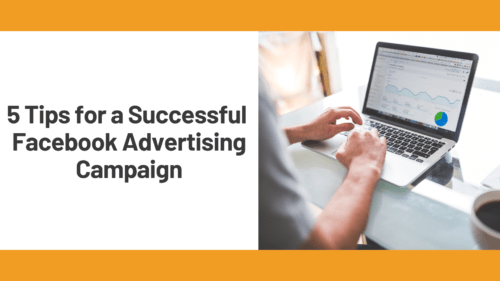
5 Tips for a Successful Facebook Advertising Campaign

In today’s modern digital age, having a comprehensive digital marketing strategy with a Facebook advertising campaign is crucial to any business. With social media at the cornerstone of digital tactics, business owners and professionals have several effective organic and paid options they can implement to engage with users, drive traffic to their website, measure ROI, and more.
While organic content is necessary and very valuable, paid content, or social media advertising, offers an inexpensive and hyper-targeted way to reach customers, showcase products and services, or even boost engagement or page likes.
Facebook is at the forefront of popular platforms used for social media advertising. Given its affordability, flexible budget options, targeting capabilities based on specific demographics, interests, behaviors, and more than one billion daily users, Facebook is the ideal channel for reaching your target audience and implementing impactful advertising campaigns.
With this being said, there are several factors you need to consider in order to develop an effective Facebook advertising campaign. Read on to learn about five tips for constructing a successful ad plan or campaign.
1. Determine Your Budget
Though there are various formulas and tools that exist to help you understand and set your ad budget based on your goal, the simplest way to think about it is money spent/budget equals impressions ($ = impressions). Essentially speaking, the more money you put into a particular ad or campaign, the more frequently your ad will be shown.
While setting a budget is important and the more money spent can increase frequency, the primary focus should be on your overall advertising strategy – I.E. audience targeting, placements, optimization, and content. No matter your budget, big or small, focusing on strategy will enable you to make the most of the dollars spent. Even though money equal impressions, note that those dollars will be wasted if they’re spent on targeting or reaching the wrong people.
2. Target the Right People
Appropriate and thoughtful audience targeting is crucial to an ad strategy. The further you can narrow your audience, the more likely your ad is to effectively reach the right people and produce the desired results.
Note, Facebook will automatically show your ads to users who are likely to find the content relevant, however, you also have the option to target your ad delivery a bit further with three audience selection tools within Facebook Ads Manager.
- Core Audiences – This audience grouping is based on demographic information such as age, interests, geography/location, behavior, etc. While setting up ads, you have the option to select these specific demographics based on your own market and audience research.
- Custom Audiences – Follow up is important, which is why these audiences allow you to reach people who have previously engaged with your business online or off. For instance, if you install a Facebook pixel on your website, you can track activity, then target those who didn’t complete a specific action – I.E. buying a product. You already have their interest; they may just need an extra nudge.
Lookalike Audiences – Using a custom audience, which can include a defined list of website visitors, email newsletter recipients, etc., Facebook can identify individuals who most closely resemble your existing customer/audience base. When creating a lookalike audience, you have the option to define it further by using a sliding scale to select a range from one to 10 percent of the combined population of your selected location. For example, a one percent lookalike audience consists of individuals who are most similar to your existing list of established consumers. Increasing the percentage will result in a broader, less identical audience.
3. Consider Appropriate Ad Placements
Remember to think about where your ad should appear and make sure you’re using placements that are appropriate for the ad content, audience, and goal.
For example, you can remove the option to place ads on Instagram if you know your audience isn’t as active or engaged on this channel. Further, if your ad content isn’t sized correctly for Facebook or Instagram stories, you should remove placements there too. This way you can avoid wasting an impression on an ad that might not be legible due to sizing incompatibilities.
4. Optimize Delivery of Ads
Facebook has options to help you optimize the people you reach based on the action you want them to take. For instance, if your goal is driving web traffic, Facebook can optimize your ad by showing it to people who are most likely to click through on links based on their previous activity online.
Facebook also allows you to alter the deliver on your ad based on whether you want to garner more impressions or reach more individuals users. When optimizing impressions, your ad will be shown a maximum amount of times per day and can reach individuals multiples time within the same day. There’s also the option to optimize ads to reach a maximum number of individuals users just one time per day. Some additional options include scheduling ads to only show during specific days and times and limiting how often your ad is shown to individual users.
5. Tailor Content
It’s important to tailor your ad content to what your audience responds to the best. To do this, analyze past content performance and compare what performed well against what didn’t. Specifically, you’ll want to look at verbiage used in copy, whether static images or videos performed better, and more to determine what your audience engages with the most.
Another way to help determine what type of content performs best among your audience is to run A/B tests. To do so, you create two versions of the ad and in one version change certain variables such as creative, audience, or placement. You can then track performance and at the end of the campaign, determine which version performed best. Ultimately, this will help improve future strategies and campaigns.
Focusing on optimizing your available budget and keeping audience targeting, placements, delivery, and content in mind is key to developing successful ad campaigns. Overwhelmed by the possibilities? We understand, and that’s why we’re here to help! Our digital marketing team works in Facebook Ads Manager every day and they know it like the back of their hands.
For more information on how PTE can help you manage and optimize your Facebook advertising campaign and digital marketing needs, contact us.
You May Like

The Importance of Setting Goals - for Career Success
Recently we had the opportunity to attend The Blue Chip Awards Luncheon. A wonderful afternoon filled with successful small business people, great food and inspirational stories, the highlight was key speaker, Nikki Stone. An Olympic gold medalist, Nikki overcame much adversity and physical challenges throughout her career and stressed the

Public Relations Strategy - 10 Steps to Ensure Success
As many of you know, I earned my APR (Accreditation in Public Relations) last year. Quite the process, I learned far more than I thought via studying assigned literature. One such piece, Cutlip & Center's Effective Public Relations 10th edition (EPR 10) was invaluable. Having practiced public relations for large

Networking: For Business and PR
Networking and communication used to take the traditional path of print advertising and brochures, direct mail, local/national trade shows, etc. These forms of communicating your brand/business still exist but more often they are used in balance with modern forms of networking and sharing information about you and your business. Here